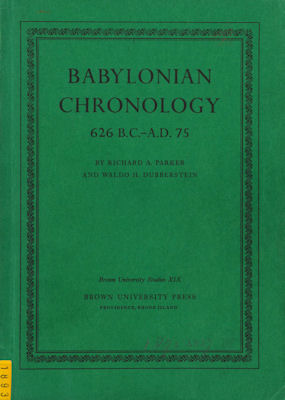
The following calendar converter is based on the tables of the Babylonian calendar published in 1971 by Parker and Dubberstein and is valid from 626/25 BCE, the accession year of the Babylonian king Nabopolassar, until 75/76 CE, i.e. year 386 of the Seleucid Era (SE) or 322 of the Arsacid Era. Outside this interval, the converter will give erroneous results.
Note that years before 1 CE are given both in astronomical as in historical notation, i.e. 0 CE = 1 BCE, –1 CE = 2 BCE, etc.
When the web page is loaded the calendar converter will output the Julian calendar equivalent of 1 Nīsannu, 1 SE (Seleucid Era), and the length of the current month. The date can be manually set to any other date between the limits given above.
Note that the Babylonian day began at sunset: the Western (proleptic Julian) dates given by the above calendar converter are the post-midnight equivalents and are as such only valid until sunset.
For the convenience of Biblical scholars the weekday is also displayed, although there is at present no evidence that the Babylonians were familiar with the seven-day cycle of the Hebrews.

This calendar converter is based on the tables of the Babylonian calendar published in 1971 by Parker and Dubberstein. These tables were based on the computed first visibility of the lunar crescent as seen from Babylon using a lunar visibility algorithm published by the German astronomer Carl Schoch (1873-1929) in Langdon & Fotheringham’s The Venus Tablets of Ammizaduga (1928).
An analysis of these tables confirms earlier claims that sequences of more than two months of either 29 or 30 days in succession occur fairly commonly: so there are 63 sequences of three 29-day months in succession and 386 sequences of three 30-day months in succession. Even longer sequences are also present but only for 30-day months: there are 79 sequences of four 30-day months in succession and there is one sequence of five 30-day months in succession (Nabonassar lunation numbers 2961 to 2965). There is also one lunation of unusual length: the month Araḫsamna in the 10th year of Darius I (Nabonassar lunation number 2916) has a length of 31 days.
As the Western calendar dates provided by this calendar converter are computed dates the actually observed dates can occasionally differ by one day if the first sighting of the lunar crescent was delayed by adverse weather conditions or advanced by other factors.
In the scholarly literature most authors usually refer to the 1956 edition of Parker & Dubberstein’s chronological tables and rarely mention the 1971 edition as this edition is commonly believed to be an unchanged reprint of the 1956 edition. The 1971 edition indeed appears to be identical with the 1956 edition: the prefaces in both editions are identical and the bibliographical sections mention no papers or studies later than 1956.
However, a careful comparison of the calendrical tables in both editions reveals that are not identical – there are three differences, all involving lunations of unusual length. The 1956 edition lists four lunations of unusual length, i.e. one month of 28 days (Nabonassar lunation number 1826) and three months of 31 days (Nabonassar lunation numbers 2685, 2916 & 5361), whereas the 1971 edition only lists one month of unusual length (Nabonassar lunation number 2916 with a length of 31 days).
A comparison of the 8670 lunations spanned by the tables of Parker & Dubberstein with (as yet unpublished) computations based on more recent luni-solar theories and the lunar visibility criterion of Bernard Yallop results in 680 lunations (7.84%) differing in the first day of the month. Of these, 583 lunations started one day earlier and 95 lunations started one day later, indicating that Schoch’s criterion is slightly less optimistic as Yallop’s criterion.
While the tables of Parker & Dubberstein list only one lunation of unusual length (31 days), the new computations indicate two unusual lunations in the same interval: one of 28 days (Nabonassar lunation number 2917) and one of 31 days (Nabonassar lunation number 1827).
As the Hebrew calendar, following the period of the Babylonian Captivity (597-539 BCE), was closely related to the Babylonian calendar, the above calendar converter can also be useful for dating Jewish historical events during the second half of the first millennium BCE.
Because the latitude of Jerusalem (31.78° N) is close to that of Babylon (32.54° N), the geometric circumstances for the first visibility of the lunar crescent are very similar for both locations. However, due to Jerusalem’s more westerly location (9.19° or 36.7 minutes west of Babylon) the lunar age and lunar elongation from the Sun, shortly after sunset, will be slightly larger than at Babylon and this will make it slightly easier to see. In some cases, when meteorological circumstances are comparable, this can result in a lunar crescent invisible at Babylon to be visible in Jerusalem or, equivalently, in a lunar month beginning one day earlier at Jerusalem than at Babylon.
Note that the rules for inserting an intercalary month in the Babylonian calendar and in the Hebrew calendar may have been different, so, although similarly named, the months in both calendars did not necessarily correspond with each other.